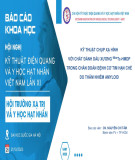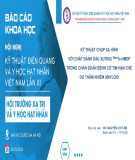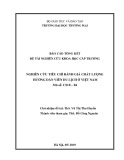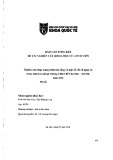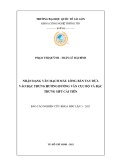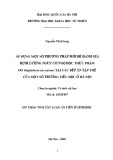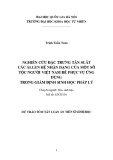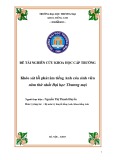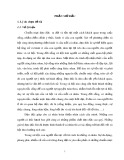
RESEARC H Open Access
Antioxidant activity of tuberosin isolated from
Pueraria tuberose Linn
Nidhi Pandey, Yamini B Tripathi
*
Abstract
Antioxidant activity of Pueraria tuberose DC, (PT) Leguminosae (Fabaceae) has already been reported by us and here
an active compound has been isolated and its action on expression of iNOS protein has been explored by using
LPS induced changes in attached rat peritoneal macrophage cell culture. The pure compound was isolated by col-
umn chromatography and its structure was characterized by spectral studies, which was identified as tuberosin
(5 hydroxy 3,4,7,3’,4’pentamethoxy flavone). Its antioxidant capacity was determined and compared with alcoholic
extract as EC
50
value for scavenging potential towards pre-generated monocation ABTS* radical, superoxide radi-
cals, hydroxyl radicals, metal chelation property and on lipid peroxidation. Further, rat peritoneal macrophages
were isolated, cultured and the attached macrophages were exposed to lipopolysaccharide (LPS) with different
concentrations of tuberosin (pretreatment for 30 min). After 17 h the released NO content, in culture supernatant,
was indirectly estimated as accumulated nitrite by Griess reagent. To understand the mechanism of action, the
extent of expression of inducible nitric oxide synthase genes, the iNOS protein was assessed in macrophage lysate
by using its antibody on western blot analysis. Tuberosin significantly scavenged all the species of FRs, described
above and it also inhibited the LPS induced release of NO and amount of iNOS protein in macrophages. All the
changes were significant and concentration dependent. Thus it could be suggested that tuberosin, is one of the
active principles of Pueraria tuberose, which directly scavenges various species of Free radicals (FRs) and also inhi-
bits LPS induced inflammatory changes in macrophages.
Background
In recent years, phyto-medicine is in great demand as
food supplement for age related chronic diseases,
because of their multi-targeted action and lesser side
effects [1] In fact, these diseases are associated with gen-
eration of excessive free radical (FR) [2] and associated
inflammation [3] and these herbal products are rich in
polyphenols, specially flavones and tannins. Therefore,
search for potent antioxidants with anti-inflammatory
potential has always been in demand. In various coun-
tries, these herbs are used as a component of their alter-
native system of medicine [4] and in Ayurveda, an
Indian system of medicine, medicinal plants are well
documented for their therapeutic claims, with records of
long clinical use, for prevention and management of sev-
eral metabolic disorders [5].
Pueraria tuberosa Linn (PT), Leguminosae (Fabaceae),
knownasBidaarikand[6]isanextensiveperennial
climber, with palmately arranged leaves, blue colored
flowers and half inches thickbark[7],growingthrough-
out tropical parts of India, mostly in moist regions, mon-
soon forests and coastal tracts. Its tuberous root, which is
brown in color and slightly curved, is in clinical use for
rejuvenation therapy. Its microscopic picture reveals the
presence of prismatic calcium crystals and tanniniferous
cells. It’s major chemical constituents include flavones
[C-glycoside (5,7,3’,5’-tetrahydroxy-4’-methoxyflavone-3’-
O-a-Lrhamnopyranosyl1®3-O-b-D-galactopyranoside)],
Isoflavones (Puerarone), Coumstan (Tuberostan, Puer-
arostan) [8], Epoxychalcanol [Puetuberosanol], (3’-
hydroxy-4’-phenoxy-a,b-epoxychalcan-a’ol)] [9], Ptero-
carpanoids [Hydroxytuberosin, Anhydroxytuberosin
(3-O-methylanhydrotuberosin)] [10], and Tuberosin [11].
The powder of PT root-tubers are in clinical use as anti-
aging and also as tonic, aphrodisiac, demulcent, lactago-
gue, purgative, cholagogue and also in scorpion sting.
Besides, it is also useful in emaciation of children, debility
and poor digestion [6,7]. Other investigators have
reported it for skin care, as anti-fertility [12]. One of its
* Correspondence: yaminiok@yahoo.com
Department of Medicinal Chemistry, Institute of Medical Science, Banaras
Hindu University, Varanasi-221005, India
Pandey and Tripathi Journal of Inflammation 2010, 7:47
http://www.journal-inflammation.com/content/7/1/47
© 2010 Pandey and Tripathi; licensee BioMed Central Ltd. This is an Open Access article distributed under the terms of the Creative
Commons Attribution License (http://creativecommons.org/licenses/by/2.0), which permits unrestricted use, distribution, and
reproduction in any medium, provided the original work is properly cited.






